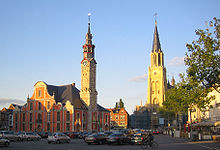Sint-Truiden
| Sint-Truiden | ||
|---|---|---|

|

|
|
|
|
||
| State : |
|
|
| Region : | Flanders | |
| Province : | Limburg | |
| District : | Hasselt | |
| Coordinates : | 50 ° 49 ′ N , 5 ° 11 ′ E | |
| Area : | 106.90 km² | |
| Residents: | 40,590 (Jan 1, 2019) | |
| Population density: | 380 inhabitants per km² | |
| Post Code: | 3800 to 3806 | |
| Prefix: | 0032 - 11/12 | |
| Mayor: | Veerle Heeren | |
Local government address : |
Kazernestraat 13 3800 Sint-Truiden |
|
| Website: | www.sint-truiden.be | |
Sint-Truiden ( Limburgish : Sintruin , French Saint-Trond ) is one of the largest cities in the Belgian province of Limburg . It is located around 15 kilometers southwest of Hasselt in the fertile Haspengau region and has 40,590 inhabitants (as of January 1, 2019). A resident of Sint-Truiden is called a Truienaar .
City structure
Structure of the urban area: Aalst, Brustem, Duras, Engelmanshoven, Gelinden, Gorsem, Groot-Gelmen, Halmaal, Kerkom-bij-Sint-Truiden, Ordingen, Runkelen, Velm, Wilderen, Zepperen
history
Around the middle of the 7th century St. Trudo a monastery on a small hill in the middle of today's city. A settlement soon arose around the monastery, which was popularized by the many pilgrims who came to the tomb of St. Trudo flocked, accumulated great wealth. Abbot Adelardus had a large abbey church and several smaller churches built in the 11th century . He had the place surrounded by a wooden palisade and the gates reinforced. In 1129 a stone wall replaced the palisade. Sint-Truiden owed its growth to a town to the profitable cloth trade. Wealthy merchants established trade connections in many cities in the Holy Roman Empire , England and northern France . Economic and social affairs were regulated by the city's 13 guilds , which later also acquired rights of participation in the city government. Sint-Truiden initially belonged to the diocese of Metz , from 1227 to the prince diocese of Liège .
From the end of the 15th century, the economic development of Sint-Truiden stagnated, a situation that lasted until the late 19th century. In 1794 French troops occupied the diocese of Liège. Sint-Truiden passed into French possession. The monastery was closed three years later. In 1815, Sint-Truiden fell to the United Netherlands . It has belonged to Belgium since 1830, with interruptions due to the German occupation in the two world wars .
Attractions
- The Sint Agnes beguinage dates back to 1258. The existing houses date from the 17th and 18th centuries and are supplemented by a Gothic church, inside of which a historical organ and wall paintings can be seen. The facility has been a UNESCO World Heritage Site "Flemish Beguinages" since 1998 .
- The town hall with the belfry on the historic market square dates from the beginning of the 17th century, the lower parts from the 13th century. The building has been a UNESCO World Heritage Site " Belfries in Belgium and France " since 1999 .
- The late Gothic Church of Our Lady ( Lievenvrouwenkerk ) has a neo-Gothic church tower (1847-1852).
- The Grote Markt of Sint-Truiden is one of the largest marketplaces in the country.
- The mighty church tower of Abdij Abbey from the 7th century stands at the north end of the market. The Benedictine abbey was founded by St. Trudo.
- To the west of the market square is the tower of the Sint-Maartenkerk , built in 1550 , a jewel of the early Renaissance . The church itself was built in the 19th century in the neo-Romanesque style.
- The Minderbroederskerk , built in 1731, stands on the south side of the market and connects to the former Ursuline monastery complex . The church is 100 m long, 16 m wide and 26 m high. The rococo interior is particularly noteworthy .
- Outside in Kortenbos is the baroque Basilica of the Assumption from the 17th century
Sons and daughters
- Deodaat Delmonte (1582–1644), Flemish architect, engineer, astronomer and painter
- Artus Quellinus II. (1625–1700), Flemish sculptor from the Quellinus family of artists
- Barthélémy de Theux de Meylandt (1794–1874), politician, twice prime minister
- Kamiel Festraets (1904–1974), watchmaker
- Odilon Polleunis (* 1943), football player
- Ivo Belet (* 1959), politician, MEP
- Danny Boffin (born 1965), football player
- Helga Stevens (* 1968), politician
- Davy Schollen (* 1978), soccer goalkeeper
- Johan Coenen (* 1979), racing cyclist
- Simon Mignolet (* 1988), soccer goalkeeper
- Timothy Stevens (* 1989), racing cyclist

